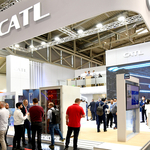
ees Europe 2023: Major Progress in New Battery Technologies
MUNICH & PFORZHEIM, Germany–(BUSINESS WIRE)–More and more electricity is being generated from renewable energies while the electromobility business is growing. Whether we are talking about sustainable power generation or electric mobility, one thing is key: Energy storage – especially battery storage. Manufacturers today primarily rely on lithium-based batteries. But now they are going one step further: The production of batteries is to become more environmentally friendly and the products more efficient, safer and cheaper. To this end, several manufacturers are now looking for alternatives – and they have found them. At ees Europe, the continent’s largest and most international exhibition for batteries and energy storage systems and the concurrent exhibitions, more than 950 suppliers will be presenting their latest products and solutions for the energy storage of the future. What’s more, attendees at the ees Europe Conference will learn first-hand where lithium-based batteries will continue to play out their advantages, but also what opportunities are opening up for other battery technologies. ees Europe is part of The smarter E Europe and will take place alongside Intersolar Europe, Power2Drive Europe and EM-Power Europe from June 14 to 16 at Messe München. 2,400 exhibitors and over 85,000 visitors from 160 countries are expected to attend in total.
On the way to a new energy and mobility world, efficient, durable and safe energy storage systems are essential. Today, manufacturers are currently primarily focusing on lithium-based batteries. But that is not enough. To make production more environmentally friendly and products more efficient, safer and cheaper, more and more research institutions and companies are working on alternative technologies – and they have already been successful.
Sodium-ion batteries: better for the environment and safer to operate
Sodium-ion batteries are seen as particularly promising. Compared to their lithium counterpart, they bring some advantages. Firstly, sodium is a natural component of salt, making it lighter, less expensive and available in large quantities. Secondly, sodium-ion batteries do not require cobalt or nickel, and are safer to operate. The materials used to make sodium-ion batteries are easier to separate and reuse, making recycling easier. According to the German Federal Institute for Materials Research and Testing, this is a “drop-in technology”, which means it can be quickly applied to mainstream battery production. Among the exhibitors at ees Europe, there are several suppliers of sodium-ion technology. One of them is the start-up company Kite-Rise Technology, who will be presenting sodium-ion solutions at the exhibition, while the Chinese company CATL has announced it will be going into series production this year.
Zinc battery storage systems present challenges and opportunities
Another new kid on the block is battery storage technology based on zinc. Their simple system design paired with high safety levels makes high-performance zinc battery storage systems stand out. Added advantages are the fact that the battery components are non-toxic and that raw material mining is possible within the EU and is more environmentally friendly. Zinc is readily and cheaply available in sufficient quantities, and the systems do not require cobalt or nickel. What’s more, established battery production processes can be used. Up until now, the biggest weakness of the new battery type is that recharging is not yet possible, meaning that zinc battery storage systems have to be recycled. Recycling requires complete reprocessing of the battery so that it can be used again. Enerpoly from Sweden will be presenting its zinc battery innovations at ees Europe, explaining what makes this technology so exciting and how it can be a key to sustainable energy storage despite its challenges.
New technologies for flow batteries
There is a lot going on in the area of flow batteries, with new technologies based on hydrogen and bromine being added to the range of options. These enable more cost-effective long-term storage, a development that impresses with its innovative power. Elestor, an exhibitor from the Netherlands, is one of the finalists of this year’s ees AWARD with its hydrogen bromine flow battery. According to Elestor, the system’s levelized cost of storage (LCOS) is two to three times lower than that of lithium-ion storage devices, and significantly lower than that of vanadium flow batteries. Bromine can be extracted from sea water in an environment-friendly way and is not subject to any geographical or political dependencies.
ees Europe 2023: new materials and technologies in the spotlight
Visitors can find out everything they need to know about battery materials and technologies at ees Europe 2023, which is being held as part of The smarter E Europe. More than 950 suppliers will be there, presenting their latest products and solutions for energy storage. In addition, on June 13 and 14, the ees Europe Conference will be putting the spotlight on the hottest industry topics, while also providing a global networking platform for the decision makers of the industry. In the session “Technology is Driving the Battery Business: Current Trends and Developments” on June 13, experts will discuss the opportunities presented by alternatives to lithium battery technology in the various stationary markets. Joining the discussion will be the Fraunhofer Institute for Solar Energy Systems (ISE), BASF, Enerpoly, SBL, ESS and Ambri Incorporated.
Contacts
Peggy Zilay
Spokesperson
The smarter E Europe
+49 7231 58598-240
Juliane Heermeier
Account Manager
+49 151 41482446


